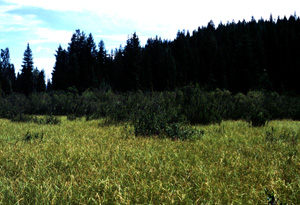Community Field Guide
Scientific Name:
Betula glandulosa / Carex utriculata Shrubland
Common Name:
Bog birch / beaked sedge Shrubland
Community Description
Environment:
This community type occurs adjacent to beaver ponds, lakes, or marshes, and on seeps, swales and wet alluvial terraces adjacent to low gradient, meandering streams (Hansen et al. 1995). This community occurs on fairly wet sites with peat accumulation, indicating a predominance of anaerobic processes. In contrast, some willow stands, like Salix drummondiana stands, commonly occur on soils that are better aerated, and hence are not usually found in peatlands. Soils are commonly flooded until mid- summer, and are saturated year- round on wetter sites. Redox concentrations are present in some mineral soils; redox depletions (gleyed soil) occur rarely. Organic matter accumulations may form floating, quaking mats as this type encroaches onto open water. Drier extremes have shallow organic horizons overlying deeper mineral soil (Hansen et al. 1995).
Vegetation:
Betula glandulosa contributes an average of 35% to the overstory. Minor amounts of Potentilla fruticosa and Salix species are usually present. The canopy cover provided by the various shrubs is sparse to moderate, but the herbaceous layer cover is high. Associated shrubs include Rhamnus alnifolia and various willows. Understory species composition is dependent on water levels. The wettest sites support Carex utriculata and Carex aquatilus. Geum macrophyllum and the graminoids Poa pratensis and Agrostis stolonifera are often present in drier micro-sites and/or disturbed sites (Hansen et al. 1995).
Range:
Betula glandulosa / Carex utriculata is a minor type at mid-elevations in western Montana (Hansen et al. 1995), and throughout Idaho (Moseley et al. 1991, Bursik and Moseley 1995).
Management:
Saturated soils are highly susceptible to soil compaction and streambank sloughing when used by livestock and heavy machinery. Overuse may result in reduced vigor or eventual elimination of shrubs from the site. Burning of this type can temporarily increase productivity of Carex species. However, care should be taken when burning along streambanks because of the excellent erosion protection provided by Betula glandulosa / Carex utriculata habitat type (Hansen et al. 1995).
Global Rank: G4? State Rank: S4
Community References
Identifier:
CEGL001079
Author:
95-09-05 / L. Williams
View Detailed Citation Information | New Community Search | NatureServe Explorer Community Information
This information is from the:
Montana Natural Heritage Program
Montana State Library--Natural Resource Information System
1515 East Sixth Ave., Helena, MT 59620-1800
406 444-3989
mtnhp.org
mtnhp@mt.gov






